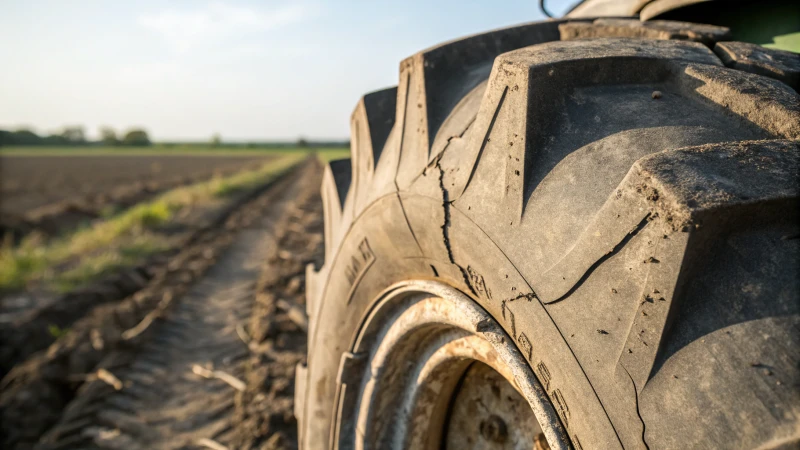When it comes to farm life, knowing when to change your tractor tires can be as crucial as the harvest itself.
You should replace your farm tractor tires when tread depth falls below 20%, visible cracks appear, or they reach 6-10 years old. These signs are crucial for maintaining safety and performance in the fields.
While these are the main signs, I’ve learned that other factors can also influence tire lifespan. Whether it's a rocky path or constant exposure to the elements, understanding these nuances helps keep my tractor running smoothly. It’s all about knowing the right time to act, ensuring that my trusty tractor stays in top form.
Tractor tires should be replaced every 5 years.False
Tires are generally replaced every 6-10 years, not 5 years.
Visible cracks in tractor tires indicate replacement is needed.True
Visible cracks can compromise safety and performance, requiring replacement.
What Are the Signs That Your Tractor Tires Need Replacing?
Picture this: You're out in the field, ready to start a long day's work, but your tractor isn't performing like it used to. Could it be the tires?
Tires need replacing if the tread depth is below 20%, cracks expose inner layers, bulges or blisters appear, or they are over 6-10 years old. Regular checks prevent costly downtimes.
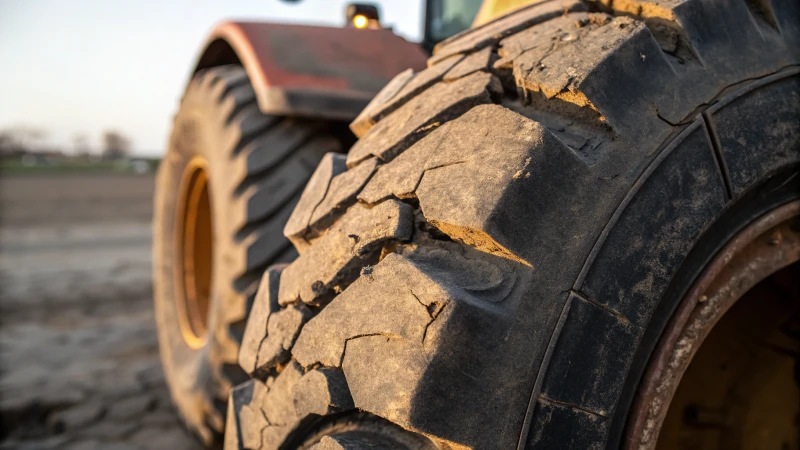
Inspecting Tread Depth
I once thought my tractor was invincible until I found myself stuck in the mud, all because of worn tread. A simple tread gauge can prevent this frustration. When the tread wears down to 20% of its original depth, you're at risk of slipping and sliding, which can be more than just an inconvenience—it can be dangerous. Regularly measuring tread depth and comparing it against manufacturer's recommendations1 can save you a lot of headaches.
Checking for Cracks and Weathering
It was a sunny afternoon when I first noticed tiny cracks snaking across my tractor’s tires. I didn’t realize at the time that these cracks, caused by relentless sun exposure and chemicals, were warning signs. Once these cracks deepen enough to expose inner layers, it’s definitely time to replace them. Keeping a regular eye on these signs can ensure your safety and keep you rolling smoothly. Check out more on weathering effects2.
Assessing Tire Age
Even if your tires look fine, age is a sneaky factor. I learned this the hard way when a seemingly perfect tire blew out during a harvest rush. Replace tires every 6-10 years, regardless of appearance, since rubber naturally deteriorates over time. The manufacturing date on the sidewall is your go-to indicator for this. Dive deeper into tire aging3 for more insights.
Identifying Bulges or Blisters
Nothing gets your heart racing like spotting a bulge on your tire right before heading to the fields. This isn’t just a cosmetic issue; it’s a ticking time bomb signaling a potential blowout. Don’t wait—replace these tires immediately. Regular inspections will catch these threats early. Learn about bulge risks4.
Practical Tips for Tire Maintenance
To keep your tires in top shape and extend their life, make sure you’re checking tire pressure regularly and rotating them to ensure even wear. Avoid overloading them and store any unused tires in a dry, covered place away from the elements. These simple steps can significantly boost tractor efficiency5 and keep your farm running smoothly.
| Sign | Why It Matters | Action Required |
|---|---|---|
| Low Tread Depth | Reduced traction increases slippage | Replace when below 20% |
| Cracks & Weathering | Compromise structural integrity | Replace if inner layers exposed |
| Age Over 6-10 Years | Rubber degradation affects safety | Replace regardless of appearance |
| Bulges or Blisters | Indicate weak spots | Immediate replacement necessary |
Tires should be replaced when tread depth is below 20%.True
When tread depth falls below 20%, it compromises traction, increasing slippage risk.
Tires older than 10 years are always safe to use.False
Rubber deteriorates over time; tires over 10 years old should be replaced.
How Does Tread Depth Affect Tractor Performance?
Ever found yourself stuck in the mud, wondering if your tractor tires are up to the task?
Tread depth is a game-changer for tractor performance, impacting traction, fuel efficiency, and safety. With the right tread, you get better grip, less slippage, and more efficient operations across varied terrains.
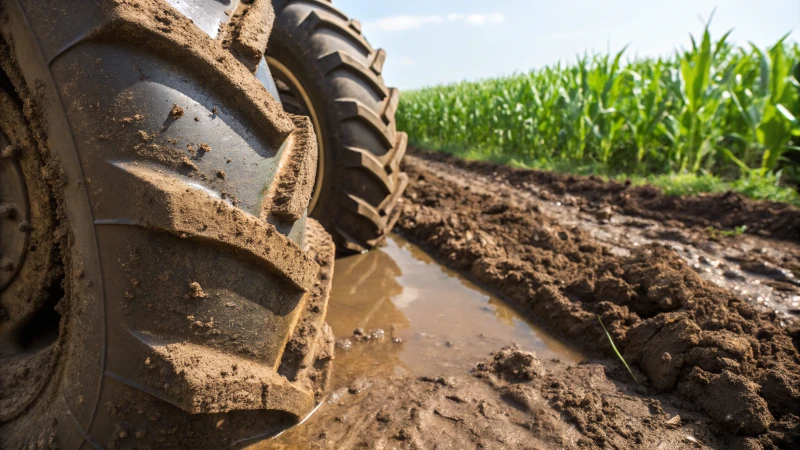
The Importance of Traction
In agricultural settings, traction is everything. It’s like having the right shoes for a hike; without it, you’re slipping and sliding all over. A good tread depth means more contact with the ground, offering better grip especially on loose or wet soils. I've learned this the hard way—finding myself in situations where reduced traction meant more headaches and higher fuel costs.
| Tread Depth | Traction Quality | Operational Challenges |
|---|---|---|
| Full Depth | High | Minimal Slippage6 |
| Half Depth | Moderate | Increased Fuel Consumption |
| Minimal Depth | Low | Reduced Speed |
Impact on Fuel Efficiency
Fuel costs can really add up, especially during busy farming seasons. When my tractor's treads were in good shape, I noticed a significant drop in fuel consumption. The tires didn’t slip as much, meaning more of the engine's power went into moving the tractor forward rather than spinning the wheels.
Safety Considerations
Safety is another big reason to keep an eye on tread depth. I can't stress enough how worn tires can make your tractor harder to control, especially on slopes or uneven ground. Regular checks are now part of my routine to prevent any nasty surprises.
Adequate tread depth helps maintain stability when navigating slopes7 or uneven terrain. Regularly checking and maintaining the tread depth can prevent potential accidents and enhance overall safety during operations.
Assessing Tread Wear
Using a tread gauge has become second nature to me. It's such a simple tool, yet it tells me so much about when it's time for new tires. Keeping up with regular inspections ensures my tractor runs smoothly and efficiently for as long as possible.
Regular inspections are recommended for long-lasting tractor efficiency8. This simple tool can help you decide when it's time to replace the tires to maintain optimal performance.
Deeper tread depth improves tractor fuel efficiency.True
Deeper treads enhance traction, reducing slippage and improving fuel efficiency.
Minimal tread depth provides optimal traction for tractors.False
Minimal tread depth reduces surface contact, leading to poor traction.
Why Should We Care About Cracks and Weathering in Tires?
Ever noticed those tiny cracks on your car tires? They might seem harmless, but they can spell disaster if ignored.
Cracks and weathering weaken tires by compromising their structural integrity, increasing the risk of blowouts and decreasing traction. These issues stem from factors like UV exposure, extreme temperatures, and chemicals, making regular inspections essential for safety.

I remember when I first realized the importance of tire maintenance. It was one of those days where everything seemed to be going wrong. I was driving to a crucial meeting, already running late, when suddenly I heard a loud pop. My heart sank as I pulled over to find a blown tire, the sidewall riddled with cracks I hadn’t noticed before.
The Role of Cracks in Tire Deterioration
Cracks can sneak up on us, appearing on the sidewalls or tread from prolonged UV exposure9. Over time, these rays break down the rubber compounds, leaving visible cracks that compromise flexibility. I learned the hard way how such deterioration can lead to blowouts, posing significant safety risks.
Moreover, moisture seeping into these cracks can accelerate corrosion, weakening the tire's core structure. Ever since that day on the side of the road, I've made it a habit to inspect my tires regularly using a tire inspection checklist to catch potential damage early.
Understanding Weathering Effects
Weathering—caused by harsh conditions like extreme temperatures and road chemicals—gradually wears down rubber, making it brittle and crack-prone. A study on tire weathering effects10 revealed how temperature swings can fatigue the material, affecting its elasticity and grip.
Table: Common Causes of Tire Weathering
| Cause | Effect on Tires |
|---|---|
| UV Radiation | Degrades rubber compounds |
| Extreme Temperatures | Causes expansion and contraction |
| Chemical Exposure | Reacts with rubber, leading to brittleness |
Practical Tips for Mitigating Damage
Since that fateful morning, I've adopted some simple practices to protect my tires:
- Regular Inspections: Monthly checks help me spot any damage before it becomes serious.
- Proper Storage: I keep my spare tires in a cool, dark spot away from sunlight and chemicals.
- Protective Coatings: I use tire protectants to guard against UV and chemical exposure.
These steps not only ensure safety but also significantly extend my tires' lifespan. Embracing tire care techniques11 has become a vital part of my vehicle maintenance routine.
UV rays cause tire cracks by breaking down rubber.True
UV rays degrade rubber compounds, leading to visible cracks.
Weathering improves tire elasticity and grip.False
Weathering degrades rubber, reducing elasticity and road grip.
When Should You Be Concerned About Tire Bulges and Blisters?
Ever had that unsettling feeling when you spot something strange on your tires? It's more serious than you might think.
The moment you notice a bulge or blister on your tire, it's time to act. These defects signal a weakened tire structure and increase the chance of a blowout. For safety, replace the tire without delay.
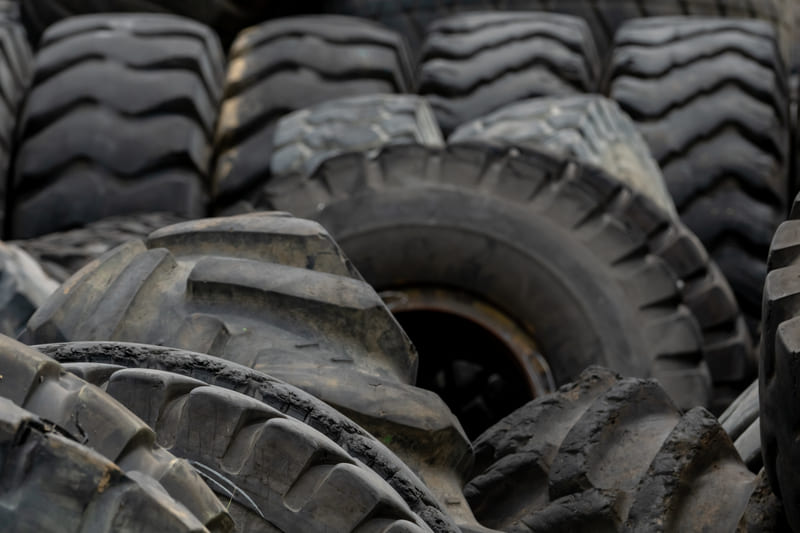
Understanding Tire Bulges and Blisters
I remember the first time I spotted a bulge on my tire. I was on a road driving to farm, miles away from home, and had just pulled over at a rest stop to stretch my legs. There it was—a noticeable bump on the side of my front tire. It was like the tire had developed a little potbelly overnight. A friend once told me that these bulges are more than cosmetic; they're a sign of something going wrong inside the tire's structure.
Tire bulges and blisters happen when there's damage in the internal layers—perhaps from hitting a curb too hard or maybe due to a flaw from the factory. Imagine it as a bruise on an apple; it looks small, but it tells you there's trouble beneath the surface. This weak spot compromises the tire’s ability to evenly distribute pressure, making it prone to blowouts.
Signs That Demand Immediate Attention
-
Size and Location:
- I learned the hard way that even small bulges shouldn't be ignored. If they appear on the sidewall, it's especially concerning because this part of the tire handles a lot of stress.
-
Changes Over Time:
- Once, I noticed a bulge that seemed to grow larger each day. That's a clear signal that things are getting worse internally.
-
Visible Cracks:
- Cracks around a bulge are like red flags waving at you, screaming for attention. They're a sign that the tire might fail soon.
Potential Causes of Tire Bulges
- Impact Damage: Remember that curb I mentioned earlier? Smacking into one can mess up your tire's insides.
- Manufacturing Defects: Sometimes, it's just bad luck with how the tire was made.
- Underinflation: I once drove with low tire pressure for too long, and it led to excessive flexing and weakening of the tires.
What Should You Do?
When faced with any of these warning signs, replacing your tire is non-negotiable. Continuing to drive could lead to a blowout at high speeds—trust me, that's not an experience anyone wants.
| Action | Reason |
|---|---|
| Inspect regularly | Early detection can prevent accidents. |
| Check tire pressure | Ensures even distribution of air, reducing stress. |
| Avoid potholes | Minimizes impact-related damage. |
| Use quality tires | Investing in reliable brands reduces manufacturing defects. |
For more insights on choosing quality tires, our guide on selecting durable tires12 is worth checking out.
Safety Measures and Precautions
- Regular Maintenance: I've made it a habit to check my tires during every oil change.
- Professional Inspection: Sometimes I second-guess myself, so I turn to a professional for peace of mind.
Being proactive about these guidelines ensures my safety and enhances my farm tractor performance. Swapping out tires at the first sign of trouble is my rule of thumb—it's better to be safe than sorry, especially when it comes to avoiding farminig hazards. After all, keeping my tractor in top shape not only protects me but extends its life too.
Frequently Asked Questions
- What are the warning signs of an imminent tire failure? Learn more here13.
- How does tire pressure affect my safety? Find out more14.
Tire bulges indicate a weakened tire structure.True
Bulges form when the internal fabric breaks, weakening the tire.
Ignoring a sidewall bulge is safe if it's small.False
Sidewall bulges are dangerous due to stress and risk of blowout.
How Can Proper Maintenance Extend Tire Life?
Ever had a tire blowout on a quiet country road? I sure have, and it taught me the importance of proper tire maintenance.
Regular tire maintenance, like checking tread depth, ensuring correct inflation, and rotating tires, can significantly extend their life. These practices not only minimize wear but also enhance safety and improve vehicle performance, saving you money in the long run.
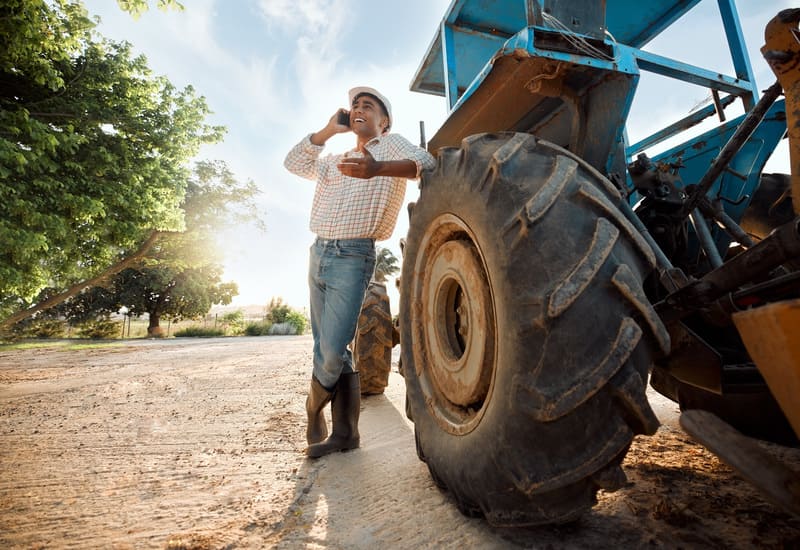
When it comes to extending the life of my tires, I think back to a time when I was stuck on the side of the road with a flat. I realized then that regular maintenance wasn't just about saving money; it was about safety and peace of mind.
Importance of Checking Tread Depth
Tread depth is crucial for traction and stability, especially in tricky terrain. I remember measuring my tire's tread with a gauge and feeling reassured, knowing replacements weren't immediately necessary. Just like agricultural tires15 should be replaced when the tread reaches 20% of its original depth, keeping an eye on this can prevent unexpected slippage.
| Tire Type | Minimum Tread Depth |
|---|---|
| Agricultural | 20% of original |
| R-1 (General) | 1.5 inches |
Inspecting for Cracks and Weathering
Exposure to UV rays can cause cracks in the rubber, and it's something I've noticed after leaving my car parked in the sun too long. Regular inspections can prevent these from turning into bigger problems.
Recognizing Damage or Cuts
Once, a small cut I ignored turned into a major headache. Even minor-looking punctures can lead to big issues if they're not addressed promptly. If you spot any damage, particularly on the sidewall, take it seriously.
Monitoring Tire Age
Tires age like we do – gracefully until they don't! Even if they look fine, replacing them every 6–10 years is wise.
Identifying Bulges or Blisters
Bulges are like ticking time bombs. They indicate a structural weakness that could cause a blowout. After noticing one, I immediately got my tires replaced, and I recommend doing the same for peace of mind.
Essential Maintenance Practices
- Proper Inflation: Regularly check tire pressure against manufacturer guidelines to ensure optimal performance; I've made it a habit every time I refuel.
- Tire Rotation: Periodically rotate tires to promote even wear; this was new to me until I realized how it promotes even wear.
- Appropriate Storage: Store unused tires in dry places away from sunlight and chemicals for longevity; it really does make a difference.
Implementing these practices has not only extended my tire life but also assured me of safer journeys on every farming trip. For more detailed insights on tire maintenance tips16, there are plenty of resources available online that can guide you further.
Tires should be replaced every 6–10 years.True
Tire materials degrade over time, affecting performance regardless of appearance.
Bulges in tires are safe and need no attention.False
Bulges indicate structural weaknesses and pose a blowout risk, needing immediate replacement.
What Are the Risks of Delaying Tire Replacement?
Ever held off on replacing those tires, thinking you could stretch them a bit longer?
Putting off tire replacement can drastically reduce traction, heighten the risk of blowouts, and undermine driving safety. By inspecting regularly and replacing on time, you ensure your farm tractor performs at its best and minimizes accident chances.
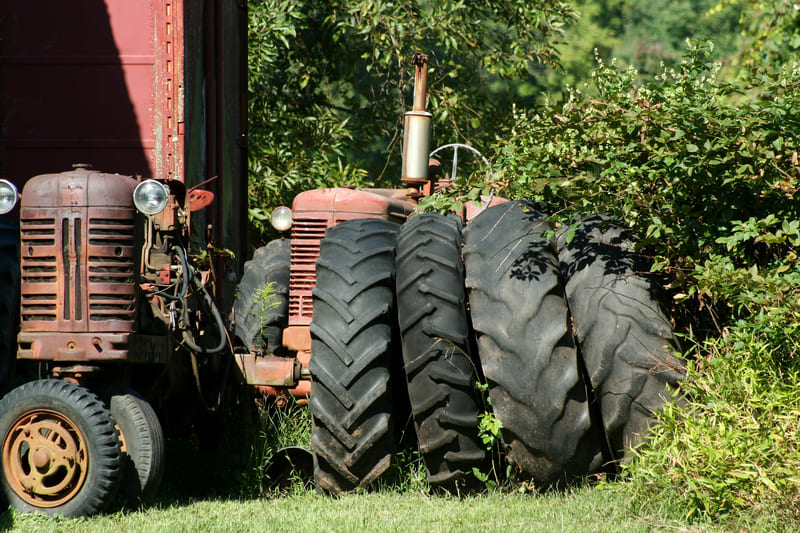
I remember that one time I procrastinated replacing my tires, thinking I'd just be careful and drive slower. But then came the rainy season, and every turn felt like a mini adventure in hydroplaning! Delaying tire replacement might seem like a money-saving idea at first, but it can quickly turn into a costly oversight.
Reduced Traction and Handling
Picture this: you're driving on a slick, rainy road, and suddenly your car isn't as grippy as it used to be. That's because worn tread can't hold onto the road effectively. I learned this the hard way, and trust me, it's not an experience you want to have when you're trying to brake on wet surfaces. Regular inspections17 can be your saving grace, catching issues before they escalate into full-blown hazards.
Increased Blowout Risk
Then there was the time my friend had an unexpected blowout on the highway, all because the tires were long overdue for a change. Older tires tend to have weak spots due to internal damage. Keep an eye out for bulges or blisters18 that could signal impending disaster.
| Warning Signs | Potential Risks |
|---|---|
| Cracks in rubber | Increased chance of blowouts |
| Worn tread | Poor traction and handling |
| Uneven wear | Misalignment or suspension issues |
Compromised Driving Safety
Every driver's nightmare is losing control during an emergency maneuver. Worn tires can increase stopping distances, making this scenario more likely. I always think about how crucial it is to have precise handling, especially when driving at high speeds. Check out tire replacement guidelines19 to know when it's time to swap those tires.
Financial Implications
Let's talk money. Holding off on tire replacement might save you today but cost you tomorrow. Uneven wear can lead to expensive repairs like alignments and suspension20 fixes. Regular maintenance doesn't just keep your wallet happy; it boosts your vehicle's performance too.
Environmental Impact
There's also an environmental angle. Worn tires decrease fuel efficiency, leading to higher emissions. Keeping your tires in check contributes to environmental conservation21 by optimizing fuel use and minimizing your carbon footprint.
Worn tires increase stopping distances.True
Worn tread reduces road grip, extending the distance needed to stop safely.
Old tires are less fuel-efficient.True
Worn tires increase rolling resistance, lowering fuel efficiency and raising emissions.
Conclusion
Replace farm tractor tires when tread depth is below 20%, visible cracks appear, or they are 6-10 years old to ensure safety and performance in the fields.
-
This link provides detailed instructions on measuring tread depth accurately, ensuring optimal tire performance. ↩
-
Discover how weathering affects tractor tires and when to consider replacements. ↩
-
Learn why it's crucial to replace tires after a certain age, even if they look fine. ↩
-
Understand the dangers of bulges in tractor tires and when to take action. ↩
-
Explore maintenance tips that can enhance your tractor's performance and extend tire life. ↩
-
This link explains how tire traction influences operational challenges, offering solutions for common slippage issues. ↩
-
Learn about the importance of tread depth in preventing accidents on uneven or sloped terrains. ↩
-
Get insights into recommended inspection intervals for ensuring long-lasting tractor performance. ↩
-
Understanding how UV rays break down rubber compounds helps in preventing premature tire deterioration. ↩
-
This provides insights into how different weather conditions affect tire longevity and safety. ↩
-
These techniques help in maintaining tire health and extending their usability. ↩
-
Discover tips on selecting high-quality tires that offer reliability and safety. ↩
-
Understand the early indicators of potential tire problems to prevent accidents. ↩
-
Explore how maintaining correct tire pressure enhances driving safety. ↩
-
Learn specific tread depth requirements for agricultural tires to ensure optimal performance. ↩
-
Explore detailed strategies for maintaining tire health and extending their lifespan. ↩
-
This link provides guidance on the frequency of tire inspections to ensure safety and performance. ↩
-
Understanding the causes of bulges helps prevent potential blowouts and enhances safety. ↩
-
This resource outlines key indicators that signify when it's time to replace your tires. ↩
-
Learn how tire wear impacts alignment, leading to further vehicle maintenance needs. ↩
-
Discover the connection between tire condition and its influence on fuel consumption and emissions. ↩

